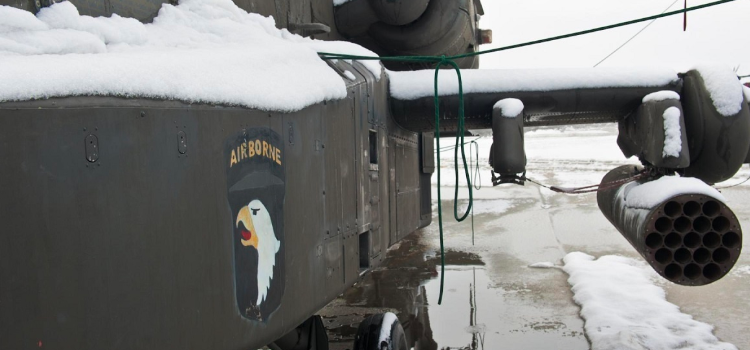When you think of airborne troops, there’s one unit that comes to mind because of its place in both history books and pop culture: the 101st Airborne Division. Nearly every major World War II film features — or at least mentions — the bravery and tenacity of the Screaming Eagles that jumped into action on D-Day.
Even after the triumphant stand of Easy Company at Hitler’s Eagle’s Nest, the 101st Airborne kept performing heroics that would land them in history books. This happened in the Vietnam War, the Persian Gulf War, and again in the Global War on Terrorism.
Today, you’d be hard-pressed to find someone who doesn’t immediately recognize the iconic 101st patch — the Screaming Eagle. And when civilians see that patch, they immediately think of elite paratroopers. Here’s the thing: we technically haven’t been an airborne unit since 1968, but you’ll still find the words “AIRBORNE” above Old Abe — here’s why.
Yes, you read that correctly. The Screaming Eagles have largely been re-designated away from the airborne world since their reactivation following Post-WWII restructuring. Fun fact: During the Korean War, the 101st was actually a training unit out of Camp Breckenridge, Kentucky, until 1953.
The unit bounced around a little before landing at Fort Campbell and being made into a “pentomic” division — meaning it was structured to fight with atomic warfare in mind. As the possibility of nuclear war grew, the role of the paratrooper in war shrank. The airborne infantrymen of the 101st were still needed — mostly involved in rapid deployment strategies — but the training was shifting with the times, and the times were changing indeed.

Funny how this thing never caught on…
(U.S. Army)
Then, on July 29th, 1965, the 1st Brigade landed at Cam Ranh Bay, South Vietnam, and the 101st adapted to their new role in the jungle. Now, we’re not saying that combat jumps into Vietnam didn’t happen — they definitely did — but the 101st wasn’t conducting them.
The Screaming Eagles were tasked with one of the largest areas of operations during the early days of the Vietnam War. Given the terrain and the nature of the enemy, airborne insertion at one point and moving from town to town just didn’t make good sense. They needed an alternative. They needed a way to get from place to place faster, efficiently, and safely. Enter the helicopter.
Helicopters saw use in the Korean War, but it was fairly rare — mostly just for medical evacuations. In the jungles of Vietnam, however, The UH-1 (or “Huey”) Iroquois and the 101st Airborne Division were like a match made in military heaven. The division designated itself as an airmobile division in mid-1968 and became the Air Assault division it is today in 1974.

In case you’re wondering. Yes. It did have a loud speaker to blast Ride of the Valkyries or Fortunate Son for Charlie to hear.
(U.S. Army photo)
That leaves the 101st Airborne Division legs in everything but name. The air assault capabilities of the 101st are the contemporary evolution of the paratroopers of old. Now, don’t get this wrong: There are still several units on Fort Campbell that are still very much on airborne status, such as the 101st Pathfinders
Today, the Screaming Eagles are the 101st Airborne Division (Air Assault) — with “Air Assault” in parentheses. It’s a more accurate description of the unit, since we’re still involved with airborne operations — just not the paratrooper, jump-out-of-planes-and-into-combat type. Screaming Eagles just fast-rope from a helicopter or wait for it to make a solid landing for insertions.
The reason “airborne” is still in the name (and on a tab above Old Abe) is because it’s difficult as hell to change a division’s name while it’s still active. Go ahead and ask the 1st Cavalry Division about the last time they rode horses into combat or the 10th Mountain Division about when they last fought on an arctic mountaintop.
The names and insignia are historic. They’re part of a legacy that still lives on within the troops.

If you really want to be technical, the airborne tab itself isn’t isn’t given to the troops. That still has to be earned individually. Think of the tab in the same vein as a unit citation.
(U.S. Army photo by Staff Sgt. Kevin Doheny)
This article originally appeared on We Are The Mighty
More From We Are The Mighty
5 Reasons Why Troops Stick Together After the Military
4 Reasons Why Showering On Deployment is Disgusting
7 of the Greatest Songs Every Veteran Knows
6 Things You’d Take Back Before Leaving the Military
6 Dumb Things Veterans Lie About on the Internet
Follow We Are The Mighty on Twitter
READ NEXT: 5 MISCONCEPTIONS TROOPS HAVE ABOUT RE-ENTERING CIVILIAN LIFE









